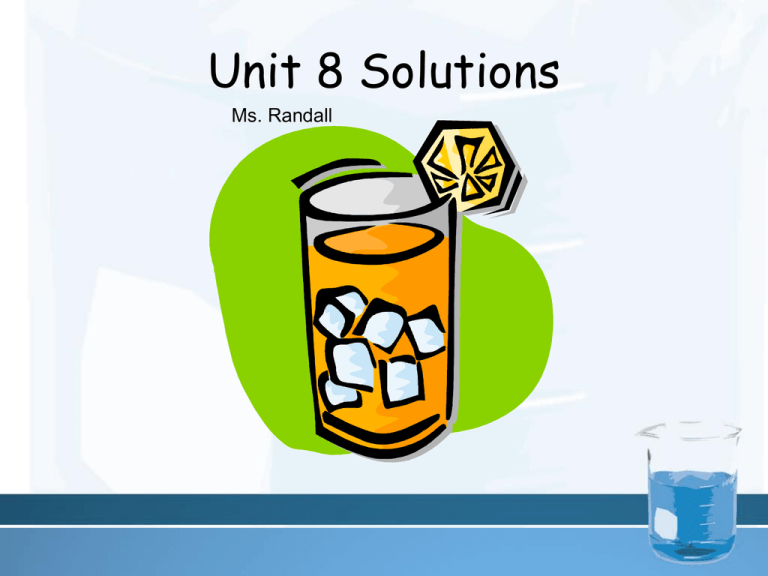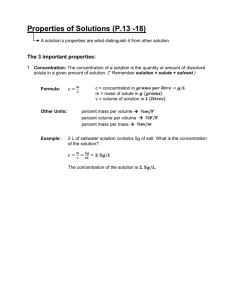
Unit 8 Solutions
Ms. Randall
Lesson 2: Types of Solutions
Objective: To determine type of
solution based on solubility curve
(reference table G). To compare and
contrast factors affecting solubility
Review of Mixtures
• A MIXTURE is: a combination of 2 or
more pure substances (elements and/or
compounds) that can be separated by
PHYSICAL means.
• MIXTURES can be categorized into one
of two groups.
HETEROGENEOUS
MIXTURE
• Mixture of 2 or more pure substances in
DIFFERENT PHYSICAL STATES;
VARYING COMPOSITION (not uniform
throughout)
HOMOGENEOUS MIXTURE
(AKA Solution)
Mixture of 2 or more pure substances in the
SAME PHYSICAL STATE; CONSTANT
COMPOSITION (uniform throughout)
Alloy
• Solution where at least one of the materials
is a METAL (although most times it is a
mixture of 2+ metals)
• Metals arrange in an alternating pattern
with SEA OF MOBILE VALENCE
ELECTRONS gluing them together
• EXAMPLE: BRASS (zinc + copper), STEEL
(iron + carbon)
Separating Mixtures
• Evaporation
• Distillation
• Filtration
Characteristics of Solutions
• HOMOGENOUS mixtures
• CLEAR (as opposed to cloudy) Can have
COLOR or be COLORLESS
• DO NOT SETTLE upon standing (after
any amount of time)
• CANNOT be separated by filtration
SOLUTIONS ARE MADE UP
OF 2 PARTS
Solute
• Substance or substances that are
DISSOLVED in a solution
– example: the salt in saltwater
• Solute is usually a SOLID and is the
LESSER quantity of the two (versus the
solvent)
Solvent• The substance that is DISSOLVING
the solute
– (example: the water in salt water)
• Solvent is usually a LIQUID and is the
GREATER quantity of the two (versus
the solute)
AQUEOUS
• A solution in which WATER is the
solvent (aq)
• Example: NaCl(aq) is otherwise known
as SALT WATER, is actually Na+(aq) +
Cl-(aq)
DIFFERENT TYPES OF SOLUTIONS
• Unsaturated
– a solution in which MORE SOLUTE
could be dissolved in a given volume of
solvent
• Saturated
– a solution containing the MAXIMUM
AMOUNT of solute that will dissolve in
a given volume of solvent
– saturated = solution EQUILIBRIUM
12
SUPERSATURATED:
• A solution that contains MORE SOLUTE
than would normally dissolve in a given
volume of solvent
• Usually requires an INCREASE in
TEMPERATURE or PRESSURE initially
(VERY UNSTABLE)
How to tell if a solution is
saturated/unsaturated or
supersaturated…
Type of
Solution
Effect of
adding
crystals to
solution
Unsaturated
Saturated
Crystals
Dissolve/
disappear
Crystals
sink to
bottom
Supersaturated
All crystals
precipitate
out
SOLUBILITY CURVES
• TABLE G shows the number of grams
of a substance that can be dissolved in
100 GRAMS OF WATER at
temperatures between 1°C and 100°C.
• Each curve represents the maximum
amount of a substance that can be
dissolved at a given temperature.
•A solution which is
on the curve is
SATURATED
•A solution below
the curve is
UNSATURATED
•A solution above
the curve is
SUPERSATURATED
16
Solubility of Solids Vs. Gases
Solids
As temperature
INCREASES,
solubility of a solid
INCREASES
Gases
As temperature
INCREASES, the
solubility of a gas
DECREASES
As pressure
INCREASES, the
solubility of a gas
INCREASES
Which are gases?
18
Factors Affecting Solubility
(Why do some things dissolve and
others do not?)
1. Nature of Solute & Solvent
• “Like” substance dissolve “like”
substances
• Example:
– Ammonia (polar) dissolves in water (polar)
– Oil (nonpolar) does not dissolve in water
(polar)
– Salt (ionic) dissolves in water (polar)
2. Temperature
Solids
Gases
As temperature ,
solubility
For MOST gases, as
temperature ,
solubility
(use table G)
Example: Dissolving
salt in warm water
Example: heat soda
carbonation is
LOST!
3. Pressure
Solid/Liquid
Solutes
LITTLE TO NO EFFECT
Gases
Dissolved in
Liquids
As pressure increases,
VOLUME and
SOLUBILITY
Check your understanding and
practice
Lesson 3: Solubility of Ionic
Compounds
Objective: To determine solubility of
an ionic substance using reference
Table F.
• Hydrogen bonds occur
between two polar
molecules, or between
different polar regions
of one large macromolecule.
• One “relatively”
negative region is
attracted to a second
“relatively” positive
region.
H
O
Electronegative
atoms
H
Hydrogen
bond
N
H
H
H
Interstitial Spaces
Oil
Oil
Oil
Oil
Oil
Oil
Oil
Non-polar
"immiscible"
Layer
dissolved
solid
Water
Water
Water
Water
Water
Water
Water
Water
Polar
red food
coloring
Dissolving of solid NaCl
Polar water molecules interact with positive
and negative ions
Animation
Zumdahl, Zumdahl, DeCoste, World of Chemistry 2002, page 468
Dissolving of solid NaCl
Na+ ClCl-
salt
Na+
Cl-
Na+
NaCl solid
(aq)
= Na+
Animation by Raymond Chang
All rights reserved.
= Cl-
Solvation
• Solvation – the process of dissolving
solute particles are surrounded by
solvent particles
solute particles are separated and
pulled into solution
Dissolving of Salt in Water
Na+
ions
Water molecules
Clions
NaCl(s) + H2O Na+(aq) + Cl-(aq)
Electrolytes
(a) Nonelectrolyte
Copyright © 2007 Pearson Benjamin Cummings. All rights reserved.
(b) Weak electrolyte
(c) Strong electrolyte
Pure water does not conduct an
electric current
Source of
electric power
Pure
water
Zumdahl, Zumdahl, DeCoste, World of Chemistry 2002, page 215
Ionic Solutions conduct a Current
Source of
electric power
Free ions
present
in water
Zumdahl, Zumdahl, DeCoste, World of Chemistry 2002, page 215
Electrolytes
Electrolytes - solutions that carry an electric current
strong electrolyte
NaCl(aq)
Na+ + Cl-
Timberlake, Chemistry 7th Edition, page 290
weak electrolyte
HF(aq)
H+ + F-
nonelectrolyte
Solubility Guidelines
• Not all substances are soluble in water
• Reference TABLE F lists solubility rules
and exceptions to those rules.
– Precipitate = INSOLUBLE product that falls to
the bottom of a mixture/solution following a
double replacement reaction.
– Precipitate will form (or a visible reaction will
occur) if ONE or BOTH of the products listed
is INSOLUBLE
38
Soluble
Not Soluble
39
Example:
• Is the compound AgCl soluble or
insoluble?
• The Cl- is found in the soluble column
BUT when it is bonded to Ag+ it is an
exception so the compound is
INSOLUBLE.
SOLUBILITY
•
Measure of how much SOLUTE will
dissolve in a certain amount of SOLVENT
at a given temp.
• SOLUBLE: will dissolve
– The more soluble something is, the more concentrated
it can be in solution
• INSOLUBLE: will NOT dissolve
CONCENTRATION
• RATIO of the amount of solute per
amount of solvent (SOLUTE/SOLVENT)
– Dilute vs. Concentrated
• DILUTE: solution that has a relatively
SMALL amount of SOLUTE dissolved
into a relatively LARGE amount of
SOLVENT (WEAK solution)
• CONCENTRATED: Solution that has a
relatively LARGE amount of SOLUTE
dissolved into a relatively SMALL
amount of SOLVENT (STRONG
solution)
Most vs. Least Concentrated
(Using Table F)
• (STRONG) vs (WEAK)
• CONCENTRATION is directly related
to amount of solute DISSOLVED
– Most concentrated = SOLUBLE compounds
– Least concentrated = INSOLUBLE
compounds
• *If a compound doesn’t dissolve, it
doesn’t add to the concentration of the
solution
REACTIONS AND TABLE F:
• EXAMPLE: Silver nitrate and sodium
chromate solutions are mixed together.
Will a precipitate form? If so, what is
the name of the precipitate?
• STEP 1 Write the chemical or word
equation for the double replacement
reaction
• 2AgNO3 + Na2CrO4 → Ag2CrO4 + 2NaNO3
• STEP 2 Check the solubility for
both products (on Table F). If there are
any that are insoluble according to
Table F, you have found your precipitate
• Ag2CrO4 = precipitate
Check your understanding and
practice
Lesson 4: Concentration
Objective: To calculate concentration in
terms of Molarity, PPM % composition.
Calculating [Concentration] - all these
formulas can be found on Table T!
1.
2.
3.
4.
Molarity (M)
Parts per Million (ppm)
Percent by Mass
Percent by Volume
Molarity
• EXAMPLE: A solution has a volume of
2.5 liters and contains .70 mol of NaCl.
What is the molarity?
• M = .70 mol = 0.28M
2.5 L
PPM
• EXAMPLE: A sample of water is found
to contain 0.010 g lead in 15. g solution.
What is the concentration in ppm?
ppm = 0.010g x 1,000,000 = 670 ppm
15.g
Percent by Mass
• EXAMPLE: What is the percent by
mass of glucose if 2.8 grams of glucose
is dissolved in 100g of water?
% mass = 2.8 g glucose = 0.28 % glucose
100 g water
Percent by volume
• EXAMPLE: What is the percent by
volume of alcohol if 40.0 mL of acetone
is diluted with water to form a total
volume of 300. mL?
40.0 mL x 100 = 13.3 %
300. mL
Check your understanding and
practice
Lesson 5: Colligative Properties of
Solutions
Objective: To determine the effects of
dissolved solute on boiling and freezing
points.
COLLIGATIVE PROPERTIES
OF SOLUTIONS
• Physical properties of solutions that
depend on the concentration of
solute in a given amount of solvent.
• When a solute is dissolved in a solvent,
solvent molecules SURROUND the
particles of the solute.
• RESULT:
– the BOILING POINT and FREEZING
POINT of the solution to CHANGE in a very
specific and predictable way.
• Boiling Point Elevation =
b.p. INCREASES when solute is added
– Ex: Adding salt to water allows you to boil
pasta at 102-103ºC (cooks it faster)
• Freezing Point Depression =
f.p. DECREASES when solute is added
– Ex: Putting salt on roads causes ice to melt
because it drops f.p. below 0ºC.
Electrolytes
• Ionic compounds in solution are called
electrolytes
• The MORE IONS a solute breaks up
into, the higher the boiling point and the
lower the freezing point of the solution
will be.
Ex. NaCl (s)
Na+1 (aq) + Cl-1 (aq)
One mole of sodium chloride dissolves to
form one mole of sodium ions and one mole
of chloride ions ( 2 moles of dissolved
ions are produced).
Ex. CaBr2 (s)
Ca+2 (aq) + 2 Br-1 (aq)
One mole of calcium bromide dissolves to
form one mole of calcium ions and two
moles of bromide ions ( 3 moles of
dissolved ions are produced)
Nonelectrolytes (covalent
compounds)
• Less impact on the melting and boiling
point of a solution than ionic compounds
do
• They DO NOT break up any further in
solution
Ex: C12H22O11 (s) =C12H22O11 (aq)
One mole of sucrose dissolves to form one
mole of dissolved sucrose.
Freezing point depressions:
NaCl = -21°C
CaCl2 = -52°C
*It’s always a good idea to have a little
CaCl2 on hand for when the REALLY cold
weather hits…
Check your understanding and
practice






